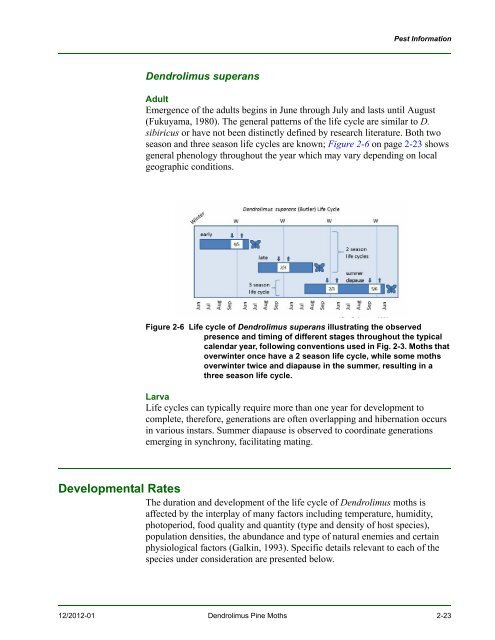New Pest Response Guidelines - aphis - US Department of Agriculture
New Pest Response Guidelines - aphis - US Department of Agriculture
New Pest Response Guidelines - aphis - US Department of Agriculture
Create successful ePaper yourself
Turn your PDF publications into a flip-book with our unique Google optimized e-Paper software.
Dendrolimus superans<br />
<strong>Pest</strong> Information<br />
Adult<br />
Emergence <strong>of</strong> the adults begins in June through July and lasts until August<br />
(Fukuyama, 1980). The general patterns <strong>of</strong> the life cycle are similar to D.<br />
sibiricus or have not been distinctly defined by research literature. Both two<br />
season and three season life cycles are known; Figure 2-6 on page 2-23 shows<br />
general phenology throughout the year which may vary depending on local<br />
geographic conditions.<br />
Figure 2-6 Life cycle <strong>of</strong> Dendrolimus superans illustrating the observed<br />
presence and timing <strong>of</strong> different stages throughout the typical<br />
calendar year, following conventions used in Fig. 2-3. Moths that<br />
overwinter once have a 2 season life cycle, while some moths<br />
overwinter twice and diapause in the summer, resulting in a<br />
three season life cycle.<br />
Larva<br />
Life cycles can typically require more than one year for development to<br />
complete, therefore, generations are <strong>of</strong>ten overlapping and hibernation occurs<br />
in various instars. Summer diapause is observed to coordinate generations<br />
emerging in synchrony, facilitating mating.<br />
Developmental Rates<br />
The duration and development <strong>of</strong> the life cycle <strong>of</strong> Dendrolimus moths is<br />
affected by the interplay <strong>of</strong> many factors including temperature, humidity,<br />
photoperiod, food quality and quantity (type and density <strong>of</strong> host species),<br />
population densities, the abundance and type <strong>of</strong> natural enemies and certain<br />
physiological factors (Galkin, 1993). Specific details relevant to each <strong>of</strong> the<br />
species under consideration are presented below.<br />
12/2012-01 Dendrolimus Pine Moths 2-23

















